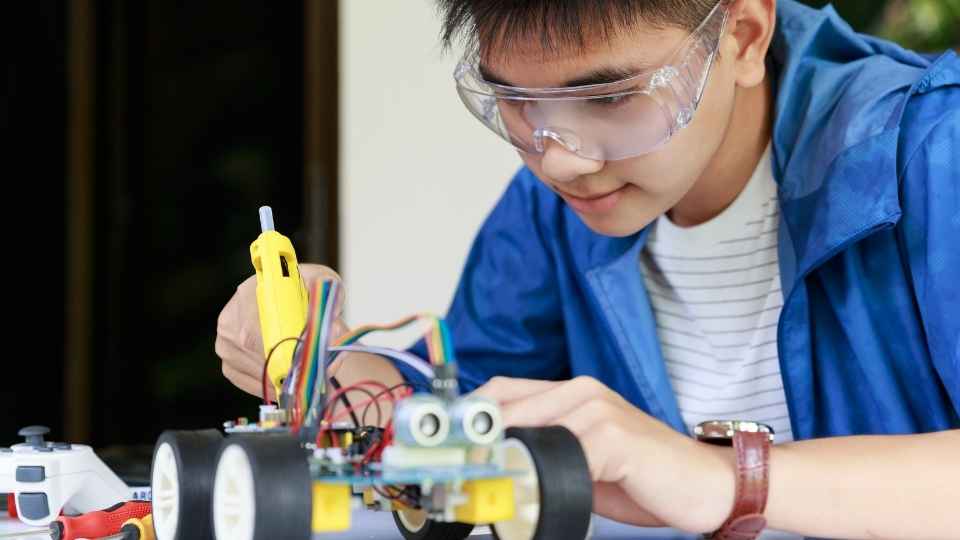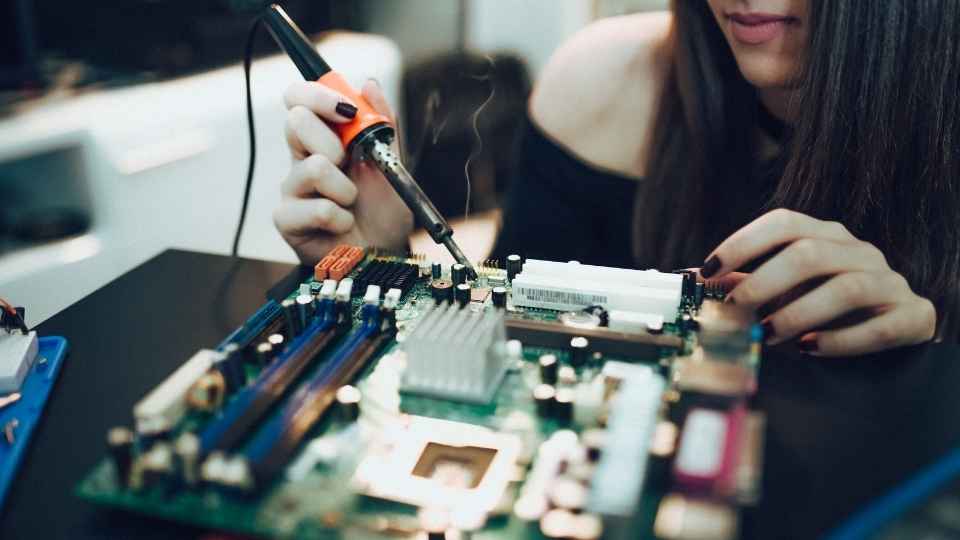
In the vast realm of technology, microcontrollers serve as the unsung heroes powering a multitude of devices. These tiny brains, akin to the hidden gears within a well-oiled machine, are responsible for driving innovation in various fields.
From IoT devices that seamlessly connect our world to automotive systems that enhance safety and efficiency, microcontrollers play a pivotal role. This article delves into the wide-ranging applications of these miniature powerhouses, exploring how they shine in industries such as medical equipment, automation, and beyond.
Key Takeaways
- Microcontrollers play a crucial role in various industries, including consumer electronics, automotive systems, medical devices, and industrial machinery.
- They enable automation, convenience, and efficiency in everyday life by seamlessly integrating software and hardware components.
- Robust security measures, such as strong authentication mechanisms and data encryption, are essential for IoT device security.
- Microcontrollers excel in enhancing vehicle performance, managing fuel injection and ignition timing, implementing advanced safety features, and powering infotainment systems in automobiles.
Exploring Embedded Systems
Embedded systems are a field of study that focuses on the design and development of computer systems that are integrated into various devices, enabling them to perform specific functions efficiently. These systems play a crucial role in numerous applications, ranging from consumer electronics like smartphones and smartwatches to automotive systems, medical devices, and industrial machinery.
The key characteristic of embedded systems is their ability to operate in real-time with limited resources such as power, memory, and processing capabilities. This requires specialized programming techniques and hardware design considerations to ensure optimal performance.
Embedded systems offer freedom by enabling devices to function independently without constant human intervention. They provide seamless integration between software and hardware components, resulting in reliable and efficient operation for a wide range of applications.
Applications in IoT Devices
IoT devices have become increasingly prevalent in various industries. They enable the connection and communication between physical objects and the digital world. These devices find applications in a wide range of fields, including healthcare, agriculture, transportation, and smart homes.
They are used for tasks such as monitoring health conditions remotely, optimizing crop irrigation based on environmental data, tracking vehicle performance, and controlling home appliances through voice commands.

Iot Device Security
With the increasing prevalence of interconnected devices, ensuring robust security measures for IoT devices has become a critical concern. As more and more devices are connected to the internet, they become potential targets for hackers and malicious actors.
To address this issue, here are four key considerations to enhance IoT device security:
Authentication: Implementing strong authentication mechanisms such as two-factor authentication or biometric authentication can help verify the identity of users and prevent unauthorized access.
Encryption: Encrypting data during transmission and storage can protect sensitive information from being intercepted or tampered with by attackers.
Regular Updates: Keeping IoT devices up-to-date with the latest security patches and firmware updates is essential to fix vulnerabilities and ensure optimal protection against emerging threats.
Secure Communication Protocols: Using secure communication protocols such as HTTPS or MQTT with TLS/SSL encryption can safeguard data transfer between IoT devices and servers, preventing eavesdropping or data manipulation.
Data Collection and Analysis
Data collection and analysis play a crucial role in gaining valuable insights and making informed decisions in the realm of interconnected devices.

In the context of microcontroller applications, data collection refers to the process of gathering information from various sensors and devices connected to the microcontroller. This data can include temperature, humidity, motion, and many other parameters depending on the specific application.
Once collected, the data is analyzed using algorithms and statistical techniques to extract meaningful patterns and trends. This analysis helps in identifying anomalies, predicting future outcomes, and optimizing performance.
The insights gained from data analysis enable developers to improve the functionality of microcontrollers, enhance user experiences, and even address security concerns.
Ultimately, data collection and analysis empower users with freedom by providing them with accurate information that can be used for better decision-making in their IoT device deployments.
Automotive Applications
Automotive applications present a wide range of opportunities for microcontrollers to demonstrate their capabilities and enhance vehicle performance. Here are four key areas where microcontrollers excel in automotive applications:
Engine Control: Microcontrollers play a crucial role in managing fuel injection, ignition timing, and emission control systems. They ensure optimal engine performance while meeting regulatory standards.
Safety Systems: Microcontrollers are vital in implementing advanced safety features like anti-lock braking systems (ABS), electronic stability control (ESC), and airbag deployment. These systems rely on real-time sensing and rapid response, which microcontrollers provide.

Infotainment Systems: Microcontrollers power the entertainment and connectivity features found in modern vehicles, such as touch screens, GPS navigation, Bluetooth connectivity, and voice recognition systems.
Electric Vehicles (EVs): EVs heavily depend on microcontroller technology for battery management, motor control, charging infrastructure integration, regenerative braking, and energy efficiency optimization.
With their versatility and reliability, microcontrollers continue to push the boundaries of automotive innovation.
Now let's explore how these tiny brains contribute to medical equipment applications.
Medical Equipment Applications
Medical equipment manufacturers rely on microcontroller technology to develop advanced devices that improve patient care and enable accurate diagnostics.
Microcontrollers are small, integrated circuits that contain a processor core, memory, and input/output peripherals. These powerful components serve as the brains behind medical equipment such as patient monitors, infusion pumps, defibrillators, and imaging machines.
Microcontrollers allow for precise control of various functions in these devices. For example, they can monitor vital signs, adjust medication dosages based on real-time data, and ensure the delivery of accurate treatment protocols. Additionally, microcontrollers enable seamless communication between different components within the medical equipment system, enhancing interoperability.

Furthermore, microcontrollers play a crucial role in ensuring safety and reliability by implementing fail-safe mechanisms and self-diagnostic features. These tiny yet sophisticated devices contribute significantly to improving patient outcomes by enabling healthcare professionals to make informed decisions based on accurate data provided by medical equipment.
Applications in Automation
Automation plays a crucial role in various industries, revolutionizing manufacturing processes and increasing efficiency.
One significant application of automation is in industrial robotics, where these machines perform repetitive tasks with precision and speed.
Industrial Robotics Impact
In the realm of industrial robotics, microcontrollers play a vital role in enhancing efficiency and productivity on factory floors. These small yet powerful devices are integrated into various aspects of robotic systems, enabling them to perform complex tasks with precision and speed.
Here are four key areas where microcontrollers shine:
Motion control: Microcontrollers provide precise control over robotic movements, allowing for smooth and accurate positioning, speed regulation, and trajectory planning.
Sensor integration: By interfacing with various sensors such as vision systems, proximity detectors, and force/torque sensors, microcontrollers enable robots to gather real-time data and make informed decisions based on the environment.

Communication: Microcontrollers facilitate seamless communication between different components of a robotic system, ensuring efficient coordination and synchronization.
Programming flexibility: With their programmable nature, microcontrollers allow for easy customization and adaptation of robot behavior to suit specific manufacturing requirements.
Efficiency in Manufacturing
Efficiency in manufacturing is crucial for companies to remain competitive in today's fast-paced global market. In order to achieve this efficiency, companies are increasingly turning to advanced technologies such as microcontrollers.
These tiny electronic devices are at the heart of many manufacturing processes, providing precise control and automation. Microcontrollers excel in tasks that require high-speed processing, low power consumption, and real-time responsiveness. They can be found in a wide range of applications within the manufacturing industry, including process control systems, robotics, and quality control systems.
By using microcontrollers, manufacturers can streamline their operations, reduce production costs, and improve product quality. These devices enable faster decision-making and allow for better synchronization between different stages of the manufacturing process.
Furthermore, microcontrollers offer flexibility and scalability for future growth. Their compact size makes them ideal for integration into existing machinery or even wearable devices used by workers on the shop floor.
Other Exciting Microcontroller Applications
One area where microcontrollers truly excel is in the realm of healthcare, where they are being utilized for various exciting applications. These tiny brains have revolutionized the healthcare industry by enabling advanced medical devices and systems that improve patient care and save lives.

Some notable applications include:
Implantable Medical Devices: Microcontrollers are used to power pacemakers, defibrillators, and neurostimulators, providing precise control over therapy delivery.
Remote Patient Monitoring: Microcontrollers enable wearable devices that monitor vital signs and transmit data to healthcare providers in real-time, allowing for proactive intervention.
Medical Imaging Equipment: Microcontrollers play a crucial role in ultrasound machines, X-ray systems, and MRI scanners by controlling image acquisition and processing algorithms.
Drug Delivery Systems: Microcontrollers regulate medication dosages in infusion pumps and insulin delivery devices with high accuracy, ensuring optimal treatment outcomes.
With their compact size, low power consumption, and high-performance capabilities, microcontrollers continue to drive innovation in the field of healthcare while empowering individuals with greater freedom over their well-being.
Frequently Asked Questions
Can Microcontrollers Be Used in Home Automation Systems?
Yes, microcontrollers can be used in home automation systems. These small but powerful devices are versatile and can control various aspects of a smart home, such as lighting, temperature, security systems, and more. They offer flexibility and efficiency in managing home automation processes.

How Are Microcontrollers Used in Wearable Devices?
Microcontrollers play a vital role in wearable devices by providing the necessary processing power and control. They enable real-time monitoring, data collection, and communication capabilities, making wearables an essential part of the growing field of personal health and fitness tracking.
Are Microcontrollers Suitable for Industrial Control Systems?
Microcontrollers are suitable for industrial control systems due to their small size, low power consumption, and ability to perform various tasks simultaneously. They can be used for monitoring and controlling processes, collecting data, and interfacing with other components in the system.
Can Microcontrollers Be Used in Robotics?
Microcontrollers can indeed be used in robotics, as they provide the necessary processing power and control for various robotic applications. Their small size and low power consumption make them ideal for embedded systems and mobile robots.
What Are Some Unique Applications of Microcontrollers in the Entertainment Industry?
Microcontrollers have unique applications in the entertainment industry. They can be used to control lighting systems, sound effects, and animatronics in theaters, theme parks, and live events, providing a seamless and immersive experience for the audience.
 Basic Electronics ConceptsEssential ToolsCircuit Design BasicsMicrocontrollersDIY Electronics ProjectsRoboticsPrivacy PolicyTerms And Conditions
Basic Electronics ConceptsEssential ToolsCircuit Design BasicsMicrocontrollersDIY Electronics ProjectsRoboticsPrivacy PolicyTerms And Conditions
